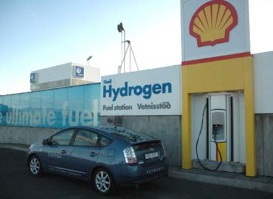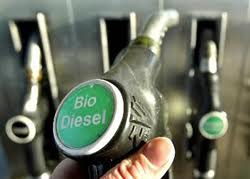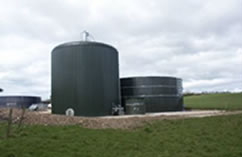
Updated 18 November 2010

|
Updated 18 November 2010 |
|
HOME PAGES GLOBAL WARMING WHAT YOU CAN DO GREEN ISSUES BACKGROUND THE INITIATIVE |
Alternatives to Petrol and Diesel At present transport is almost entirely dependent, either directly or indirectly, on fossil fuels. In the future, alternatives to fossil fuels will have to found as fossil fuel deposits are depleted and carbon dioxide emissions causing global warming must be reduced. The following alternatives to fossil fuels are discussed below:
On this page we also have a brief comment about hydrogen, which is covered very fully on a separate page. Electric cars are covered on our choosing a car page. Summary of Conclusions Hydrogen: Despite its promise there are many difficulties – it seems more likely that the green alternative to petrol will be a fuel such as methanol, which can be created from hydrogen and is easier to handle. Biofuels: The current first-generation biofuels are not convincingly green, and have caused economic, social and environmental problems. Research and development are needed to find better biofuel solutions. Propane and butane (LPG): This is not a green option, and cannot be recommended. Dual-fuel cars using petrol and LPG are not convenient, and as LPG is not widely available a pure LPG-powered car is not a viable option. Methane: Methane produced as biogas seems better suited to be a replacement for natural gas than as a motor fuel. Methanol: Methanol may well be chosen as the preferred fuel for transporting energy from renewable resources. It has significant advantages over hydrogen. Dimethyl ether: Produced from organic waste or biomass, dimethyl ether is a promising, clean replacement for diesel. 
Hydrogen is in some ways the ideal fuel. It can be produced from water using green electricity, and the product of burning it is just water. It can also be used to generate electricity in fuel cells. As a result there has been considerable work to try and overcome the many problems of using it widely as a fuel. There is a very full discussion on our separate hydrogen page In this section we discuss fuels that are primarily obtained in a carbon-neutral way from biomass. However, it is important to note that some of the fuels discussed outside this section, such as methane and methanol, can also be produced as biofuels rather than from fossil fuels. The term biofuels covers a wide range of fuels which in some way are derived from biomass. Although they cover solids, liquids and gases, it is mainly liquids that are of interest as replacements for petrol and diesel. At present, liquid biofuels are used both on their own or mixed with petrol or diesel. Gases can also be used. However, solids are not convenient motor fuels so we will not discuss biofuels such as wood chips and charcoal. Biofuels claim to be carbon neutral since an equal amount of carbon dioxide is consumed in the production of the fuel to that produced when it is burned. However, in reality they can not be entirely carbon neutral because energy is required to grow the crops and to convert them into fuel. In principle, biofuels are an attractive replacement for fossil fuels used in transport. The European Union has set biofuel targets of 5.75% by 2010 and 10% by 2020. However, critics say that current biofuels scarcely reduce greenhouse gas emissions, and cause food price rises and deforestation. There are three, or even four generations of biofuels to consider. The first generation already exists, while the second and third generations are still under development. The fourth generation is not yet well-defined and is speculative. Biofuels beyond the first generation are sometimes called 'advanced' biofuels. First generation biofuels First generation biofuels fall into two categories:
The alcohols are made using sugar or starch from grains such as maize or wheat, or from sugar cane. The oils are made from seeds such as oil-seed rape or palm nut oil. First generation biofuels are controversial for several reasons – this is discussed below. 
Alcohols for use in petrol engines can be produced by fermenting and distilling sugars or starches in grains or seeds to produce mainly ethanol, and sometimes propanol or butanol. Ethanol, or ethyl alcohol (the alcohol in our alcoholic drinks) is by far the most widely used. It can be mixed with petrol to any percentage, and it can replace it entirely. Most existing car engines can run without modification on a mixture of up to 15% ethanol in petrol. The leading users of ethanol are Brazil and the United States. In principle, any crop that is used to produce alcoholic beverages could be used as a feedstock. Distillation to purify the ethanol requires significant heat energy, often using unsustainable natural gas. Ethanol produces about one-third less energy per litre than petrol, so fuel consumption is higher. This either reduces the driving range or requires a larger fuel tank. Brazil introduced ethanol made from sugar cane (photo) mixed with petrol as long ago as 1976. A very efficient agricultural and industrial system is used for production. The heat energy for distillation comes from the burning the waste left after the sugar cane has been pressed. All petrol in Brazil must now contain 25% ethanol, which requires a minor adjustment to petrol car engines. In addition, pure bioethanol has also been on sale since 2003, and due to the availability of flexible-fuel vehicles that can run on any mixture of ethanol and petrol it now has more than half the market. Despite this success, there are serious questions about whether a country without the land resources or tropical climate of Brazil could duplicate its success. The United States has encouraged production of bioethanol from maize (corn) with generous government subsidies. A blend of 10% ethanol with petrol is widely used. With the availability of flexible-fuel vehicles the use of E85, which is 85% ethanol and 15% petrol, has become more common. The reason for not going to E100, i.e. pure ethanol, is because of cold-starting and emissions problems in very cold weather, which does not occur in Brazil. 
Biodiesel is the most common biofuel in Europe. The main crop used is oil-seed rape, which accounts for most of production. However, some palm oil grown in the tropics is also being used as demand rises. Other oily seeds, such as soy beans, sunflower and mustard, as well as animal fats, can also be used. Biodiesel is similar in composition to ordinary mineral diesel from crude oil. Blends of biodiesel and mineral diesel are distributed for use in the retail market. In a similar way to bioethanol, the percentage of biodiesel in the mix is given by a number – for example, B100 is pure biodiesel, while B5 is 5% biodiesel. and is widely used in Europe. Modern, clean diesel engines, most commonly using electronically controlled common-rail fuel injection, are very sensitive to the viscosity of the fuel and must be modified in order to run with large fractions of biodiesel. The majority of vehicle manufactures limit their recommendations to a 15% biodiesel blend. Cheap cooking oil, either bought in a supermarket or recycled after use (for example from frying in restaurants), can be converted into a usable biodiesel that can be burned in older diesel engines without damage. However, it is not safe to use it in the more sensitive, modern diesel engines. Use of cooking oil invalidates diesel car warranties. It may also damage expensive catalytic converters and thereby cause them to fail an MOT. There are also questions about air pollution from burning these products. Butanol is an alcohol that can be produced, like ethanol, by fermenting and distilling starch or sugar from a variety of crops. It is sometimes called biogasoline, as it can be used in its pure form as a direct replacement for petrol in an unmodified engine. Although it provides about 10% less energy than petrol, it has 30% more energy than ethanol and almost twice as much as methanol. It is also less corrosive than ethanol or methanol, and can therefore be distributed using existing petrol pipes. Recently it has been shown that butanol can be made using waste liquid and grain left from whisky making – initial claims are that this could supply much of the motor fuel used in Scotland. 
First generation biofuel problems As bioethanol production from maize expands in the United States, and biodiesel becomes more widely used in Europe, some serious problems are already apparent. Analysis of the production of ethanol from maize in the United States shows that if the total energy consumed by farm equipment, planting, fertilisers, pesticides, herbicides and fungicides, irrigation systems, harvesting, transport of the crop, fermentation and distillation, as well as distribution of the resulting fuel, is considered then the net benefit compared to using petrol as fuel is tiny, if indeed there is any benefit at all. On top of that, the huge expansion of the amount of arable land used to grow the crops for bioethanol have already had a big effect on the supply of grain for food – the 'food versus fuel' debate. Global prices for maize and wheat have risen sharply, and this has caused severe problems and food riots in poor countries around the globe (photo). The use of palm oil for making biodiesel, among many other uses for palm oil, has led to widespread tropical deforestation and soil erosion as palm oil production is expanded. * First generation biofuels have not convincingly solved the problem of producing green motor fuel, and they cause economic, social and environmental problems. Second generation biofuels are fuels derived from non-food crops or waste material, so they do not divert food away from the animal or human food chain. Feedstock for second generation biofuels include waste from food crops such as stalks of wheat or maize and other woody waste material, as well as special biomass crops (such as miscanthus, or elephant grass) grown on land not suitable for growing food. 
One method is to convert cellulose instead of sugar and starch into liquid biofuels such as ethanol, methanol and biodiesel. This is difficult. One way is to first convert the cellulose into sugars (which may require energy), which can be converted easily into alcohol. Another is the use of a unique fungus from Patagonia to convert cellulose into hydrocarbons similar to diesel fuel. Third generation biofuel is derived from algae (photo). Algae are low-input, high-yield feedstocks to produce biofuels. They are seen by many experts as promising a source of green fuel. Ranging from single-celled organisms to large seaweeds, they are the world's most abundant form of plant life and, via photosynthesis, are extremely efficient at using sunlight and carbon dioxide from the air to make organic material such as sugars, proteins and, under the right conditions, oils. Based on laboratory experiments, it is claimed that algae can produce up to 30 times more energy per hectare than land crops such as soy beans. Unlike other methods of biofuel production, which first harvest organic matter and then convert it to a fuel, some algae produce ethanol naturally and it can then be collected without killing the algae. Other species of algae can produce oil, which can be turned into biodiesel. * Second and third generation biofuels are promising, but much more research and development is needed. 
Liquid petroleum gas (LPG) is a term applied to a mixture of propane and butane. These gases can be liquified by compression, and a mixture of the two used as fuel is known as liquid petroleum gas, or LPG. Although used as a motor fuel, the primary use of LPG in the UK is actually for heating and cooking in rural areas, as well as barbecues and patio heaters. When used for vehicles it is also called Autogas. LPG is a relatively clean fuel, producing less carbon dioxide and considerably less other pollutants than petrol, and LPG cars are exempt from the London congestion charge. However, LPG is normally obtained from crude oil, or by separating butane and propane from natural gas supplies. Thus it is not a green alternative. The gas is supplied in pressurised form in cylinders, which reduces the volume required by about 250:1. The gas has more energy per gram than petrol, but is much lighter and so more bulky to store. The mixture has a small amount of a pungent gas – usually ethanethiol – added so that leaks can be detected. The proportions of propane and butane vary, and similar considerations apply to the use of either gas by itself. Depending largely on government encouragement via the tax regime, LPG or pure propane is widely used as a replacement for petrol in powering vehicles – worldwide there are over 10 million such vehicles in use. However, in the UK they are rare because of a lack of options for refuelling, and one cannot buy a mainstream car fuelled just by LPG. Cars that can be switched between using LPG or petrol are produced by a few mainstream companies – an example is the Proton Ecologic. Cars can be adapted for LPG fuel by specialist companies, and the fuel tank then takes up significant space in the boot (photo) or replaces the spare tyre. However such converted cars can lead to problems with maintenance and insurance. Compared to running a car on petrol, fuel consumption is somewhat worse, which erodes some of the saving in the price of fuel, and power output is reduced. * The choice of a dual petrol/LPG powered car or a pure LPG powered car is not recommended. It is not a green option as the source is normally a fossil fuel, there are few models available, and there can be significant difficulty in locating LPG fuel. 
Methane is a naturally occurring gas, the 'natural gas' that we use in our homes and which is extracted along with oil. In that form it is therefore a fossil fuel. However, it can also be produced by anaerobic 'digestion' (fermentation), of waste organic matter, manure, plant material or energy crops as so-called 'biogas' (photo). This could be distributed using the existing gas mains, unlike some other alternative fuels that would require completely new infrastructure. Methane is a much more potent greenhouse gas than carbon dioxide. The amount in the atmosphere is now more than two and a half times what it was in 1750, and higher than at any time for 400,000 years. As global warming proceeds, there are fears of huge releases of methane from the melting of frozen peat bogs, notably in Siberia, and of releases from deposits of methane compounds buried in deep ocean sediments, greatly accelerating global warming. Methane in the form of natural gas is of course widely used for electrical generation, as well as a fuel for central heating, hot water production and cooking. Compared to coal or oil, burning methane produces less carbon dioxide for each unit of heat released. Methane in the form of compressed natural gas can be used as a vehicle fuel, and is claimed to be more environmentally friendly than other fossil fuels such as petrol and diesel. However, the low density of compressed gas means that it struggles to compete with liquid fuels because large fuel tanks are needed. * Methane produced as biogas could replace natural gas for electricity generation and as a domestic fuel. But as a gas it seems less suited for use as a motor fuel. Methanol has historically been produced by the destructive distillation (pyrolysis) of wood, hence its name as 'wood alcohol'. It is a possible liquid fuel to replace petrol as it can be burnt in conventional engines, and it can be generated as a largely green fuel. Methanol has significant advantages over hydrogen, most significantly having more energy per unit volume than even liquid hydrogen but without the problems of holding hydrogen at extremely low temperatures. It is already used as a motor fuel in specialised applications, for example in various motor sports including drag racing. Its green credentials arise from the fact that it can be generated from carbon dioxide and hydrogen, as well as from biomass. This removes a greenhouse gas, and the hydrogen can be generated using renewable energy – though at present most hydrogen is produced during the processing of fossil fuels. However, at present methanol is produced from methane. For use in petrol engines it is often mixed with 15% of petrol, which overcomes its tendency not to start in cold weather. It can also be converted to dimethyl ether, which is a gas that can be used without much modification in diesel engines, where it burns very cleanly. Dimethyl ether is sometimes mixed with LPG as a substitute for propane. Methanol can also be used to power fuel cells. Direct-methanol fuel cells (DMFC) are fairly simple to make but relatively inefficient. More complex systems first process the methanol to extract the hydrogen and then use the hydrogen in a fuel cell. Methanol's main disadvantages compared with petrol include:
Its advantages are:
* Methanol may well be chosen as the preferred fuel for transporting energy from renewable resources. It has significant advantages over hydrogen. DME is a promising, clean-burning fuel for diesel engines. At present it is produced from natural gas or coal via a complex series of steps, but these would also work using waste organic matter or biomass as inputs. Production via more efficient and direct processes is also being developed. A big advantage of DME is very low emissions of particulate matter, nitrogen oxides and carbon monoxide pollutants when burned in diesel engines – it satisfies recent emission regulations in Europe (Euro 5), the US and Japan. Current diesel engines only need minor modification to burn DME. The main uses of DME at present are as a replacement for propane in LPG, and as a propellent in aerosol cans. * Provided it is produced sustainably, from organic waste or biomass, dimethyl ether might be a clean replacement for diesel. |
 |
If you have any comments or queries about this website please contact the
webmaster. |
© Blewbury Energy Initiative 2014 |